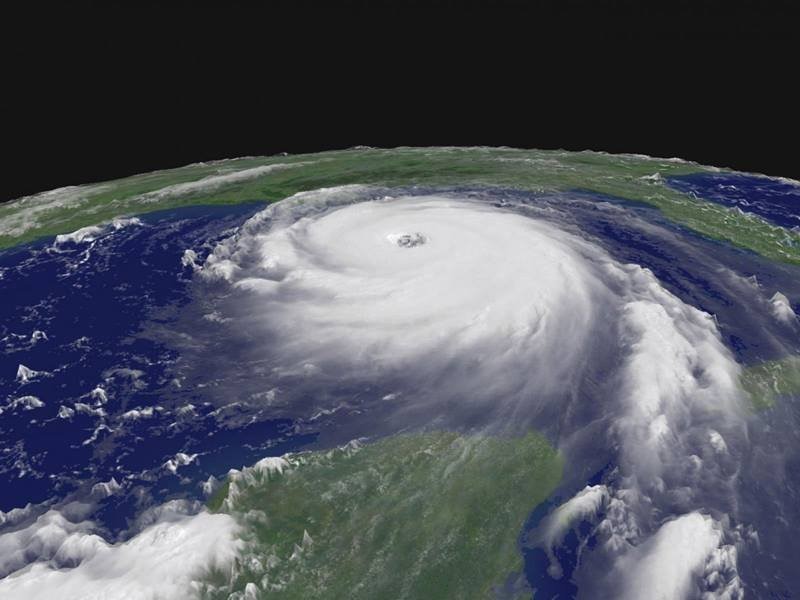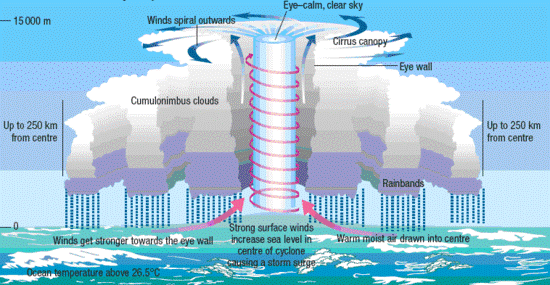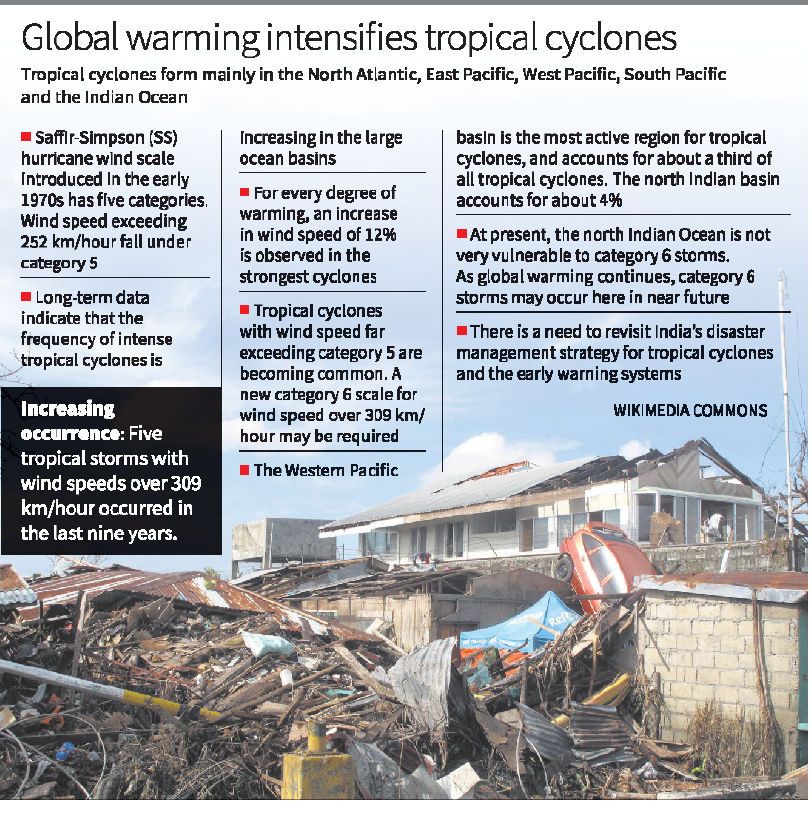Description

Disclaimer: Copyright infringement not intended.
Context
In a recent research paper published in the Proceedings of National Academy of Sciences, the authors proposed to introduce a hypothetical modification of the SS wind scale to tie category 5 to peak wind speeds between 252-309 km/hour and to include an additional category 6 above 309 km/hour.
Details
Cyclones
- Cyclones are caused by atmospheric disturbances around a low-pressure area distinguished by swift and often destructive air circulation.
- Cyclones are usually accompanied by violent storms and bad weather.
- The air circulates inward in an anticlockwise direction in the Northern hemisphere and clockwise in the Southern hemisphere.
- classified as:
- Extra tropical cyclones (also called temperate cyclones)
- Tropical cyclones.
- The word Cyclone is derived from the Greek word Cyclos meaning the coils of a snake.
- It was coined by Henry Peddington because the tropical storms in the Bay of Bengal and the Arabian Sea appear like coiled serpents of the sea.
- The World Meteorological Organisation (WMO, 1976) uses the term 'Tropical Cyclone’ to cover weather systems in which winds exceed ‘Gale Force’ (minimum of 34 knots or 63 kph).
Tropical cyclones
- Cyclones that developin the regions between the Tropics of Capricorn and Cancer are called tropical cyclones.
How they form
- The development cycle of tropical cyclonesmay be divided into three stages:

Formation and Initial Development Stage
- The formation and initial development of a cyclonic storm depends upon various conditions. These are:
- A warm sea (a temperature in excess of 26 degrees Celsius to a depth of 60 m) with abundant and turbulent transfer of water vapour to the overlying atmosphere by evaporation.
- Presence of the Coriolis force: The Coriolis force is zero at the equator (no cyclones at equator because of zero Coriolis Force) but it increases with latitude.
- Coriolis force at 5° latitude is significant enough to create a storm.
- The earth’s spinning (Coriolis effect) causes air movement to be circular, this starts the spinning towards the centre of the storm.
- Atmospheric instability encouraging formation of massive vertical cumulus clouds due to convection with condensation of rising air above ocean surface.

Mature Tropical Cyclones
- When a tropical storm intensifies, the air rises in vigorous thunderstorms and tends to spread out horizontally at the tropopause level.
- Once air spreads out, a positive perturbation pressure at high levels is produced, which accelerates the downward motion of air due to convection.
- With the inducement of subsidence, air warms up by compression and a warm ‘Eye’ is generated.
- Generally, the ‘Eye’ of the storms has three basic shapes: circular; concentric; and elliptical.
- The main physical feature of a mature tropical cyclone in the Indian Ocean is a concentric pattern of highly turbulent giant cumulus thundercloud bands.
Modification and Decay
- A tropical cyclone begins to weaken in terms of its central low pressure, internal warmth and extremely high speeds, as soon as its source of warm moist air begins to ebb, or is abruptly cut off.
- This happens after its landfall or when it passes over cold waters or moves over land it starts to lose energy and fades.
Worldwide distribution and terminology
- Climatologically, tropical cyclones form mainly in the North Atlantic, East Pacific, West Pacific, South Pacific and the Indian Ocean.
- Out of 85 tropical storms that develop annually over the warm tropical oceans, more than half (45) of them intensify into tropical cyclones.
- The Western Pacific basin is the most active region for tropical cyclones and accounts for about a third of the world’s tropical cyclones.
- The North Indian basin accounts for only about 4% of the global total, although it is one of the most vulnerable regions in the world to the effects of such cyclones.
Terminology
- They are known as typhoons in the China Sea and Pacific Ocean; hurricanes in the West Indian islands in the Caribbean Sea and Atlantic Ocean; tornados in the Guinea lands of West Africa and southern USA.; willy-willies in north-western Australia and tropical cyclones in the Indian Ocean.
Naming of Tropical cyclones
Why is it important to name cyclones
- The cyclones are named to help people identify them easilyas it would be difficult to remember numbers and technical terms. Additionally, appending names makes it easier for the media, scientific community and the disaster management community to identify and report individual cyclones, disseminate warnings, increase community preparedness, and ward off confusion in areas that witness multiple cyclones.
How they named
- The cyclones that are formed in any ocean basin around the world are named by the Regional Specialised Meteorological Centres (RSMCs) and Tropical Cyclone Warning Centres (TCWCs).
- There are a total of six RSMCs in the world, including the India Meteorological Department (IMD).
- The World Meteorological Organization (WMO) and the United Nations Economic and Social Commission for the Asia Pacific (ESCAP) have been naming cyclonic storms since 2000.
- The India Meteorological Department (IMD) names the cyclones developing over the north Indian Ocean, including the Bay of Bengal and the Arabian Sea. It also issues advisories to 12 other nations in the region on the development of cyclones and storms.
- In 2000, a group of nations called WMO/ESCAP-- Bangladesh, India, the Maldives, Myanmar, Oman, Pakistan, Sri Lanka and Thailand-- decided to name cyclones in the region.
- In 2018, five more countries were added-- Iran, Qatar, Saudi Arabia, United Arab Emirates and Yemen.After the aforementioned countries sent in suggestions, the WMO/ESCAP Panel on Tropical Cyclones (PTC) finalise the list.
The guidelines to name the cyclones:
- The proposed name must be neutral to politics and political figures, religious beliefs, cultures and genders.
- It must not hurt the sentiments of any group of people across the world.
- It must not be rude and cruel in nature.
- The name must be short, easy to pronounce and inoffensive to any member.
- It must be of a maximum of eight letters and be given with its pronunciation and voice over.
- The names of cyclones developing over the north Indian Ocean will not be repeated. Once used, it will cease to be used again.
In India, cyclones are classified by
- Strength of associated winds,
- Storm surges
- Exceptional rainfall occurrences
Criteria has been formulated by the Indian Meteorological Department (IMD)
- Which classifies the low pressure systems in the Bay of Bengal and the Arabian Sea on the basis of capacity to damage, which is adopted by the WMO.
|
Type of Disturbances
|
Wind Speed in Km/h
|
Wind Speed in Knots
|
|
Low Pressure
|
Less than 31
|
Less than 17
|
|
Depression
|
31-49
|
17-27
|
|
Deep Depression
|
49-61
|
27-33
|
|
Cyclonic Storm
|
61-88
|
33-47
|
|
Severe Cyclonic Storm
|
88-117
|
47-63
|
|
Super Cyclone
|
More than 221
|
More than 120
|
- 1 knot - 1.85 km per hour
About the NEWS
Tropical cyclones of higher intensity demand a new categor
Background
- The Saffir-Simpson (SS) hurricane wind scale, introduced in the early 1970s, is the most widely used metric for warning the public about the dangers of tropical cyclones.
- The SS hurricane wind scales are categorised by the maximum sustained wind speed at a height of 10 metres.
- Although most tropical cyclone-related deaths are caused by storm surge and heavy rainfall, wind hazard remains an important metric for communicating risk to the public and a critical metric for measuring the impact of these cyclones.
- There are five categories on the SS hurricane wind scale — category 1 to category 5 — with category 5 wind speed exceeding 252 km/hour. The combined effects of wind, storm surge, and rainfall in a category 5 impact would completely raze any structure.
|
Cyclone Category
|
Wind Speed in Km/h
|
Damage Capacity
|
|
01
|
120-150
|
Minimal
|
|
02
|
150-180
|
Moderate
|
|
03
|
180-210
|
Extensive
|
|
04
|
210-250
|
Extreme
|
|
05
|
250 and above
|
Catastrophic
|
Climate change impact
- The sharp rise in man-made greenhouse gas emissions has led to global warming of the order of 10 degree C since pre-industrial times.
- The warming can be observed not only at the sea surface, but also in the depths of the ocean, which increases the heat content of the ocean and thus favours the intensification of tropical cyclones.
- Long-term data indicate that the frequency of intense tropical cyclones is increasing in the large ocean basins. For every degree of warming, an increase in wind speed of 12% is observed in the strongest cyclones, which corresponds to a 40% increase in destructive potential.
- As warm waters extend further poleward, cyclones are shifting poleward, with more storms forming at higher latitudes than in the past.
- A warmer atmosphere can hold more moisture, leading to heavier rainfall when tropical cyclones make landfall.
- As the oceans warm, cyclones also strengthen faster and spend more lifetime over the oceans. In 2023, tropical cyclone Freddy spent 37 days over the oceans, making it the longest-lived cyclones ever recorded.

Category 5
- In a recent research paper shows storms are occurring at intensities well above Category 5 and that record wind speeds are likely to continue as the planet continues to warm.
- At the time the SS wind scale did not foresee the need for a tropical cyclone-beyond category 5. However, due to global warming, there is now a need to define a category 6 cyclone.
- Therefore proposed to introduce a hypothetical modification of the SS wind scale to tie category 5 to peak wind speeds between 252-309 km/hour and to include an additional category 6 above 309 km/hour.

Past observations
- Observations indicate that of the 197 tropical cyclones categorised as category 5 in the 42-year period from 1980 to 2021, half occurred in the last 17 years of the period.
- Five of these storms which occurred in the last nine years of the record, exceeded the hypothetical category 6 (with wind speeds of over 309 km/hour).
- Simulations of future climate change suggest that the annual exceedance of the category 6 threshold will increase even more in the regions where intense tropical cyclones currently occur.
- It is expected that the proposed 6th category of the SS wind scale could raise awareness of the dangers of the increased risk of large cyclones due to global warming.
Indian Context
- At present, the North Indian Ocean is not as vulnerable to category 6 storms.
- However, as global warming continues unabated, there is a good chance that a category 6 storm with maximum wind speeds of over 309 km/hour may occur over the North Indian Ocean in the near future. Therefore, there is a need to revisit India’s disaster management strategy for tropical cyclones and the early warning systems.
|
PRACTICE QUESTIONS
With reference to 'Tropical cyclones', consider the following statements:
- They originate over warm tropical oceans.
- They are associated with heavy rainfall and storm surges.
- They are not found at latitudes above 20 degrees.
How many of the statements given above is/are correct?
- Only one
- Only two
- All three
- None
Answer B
|












